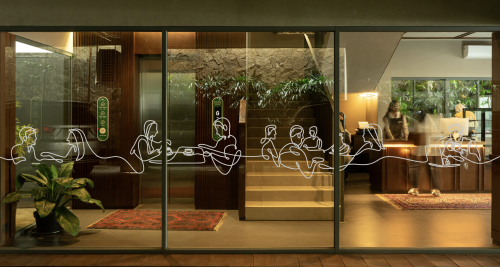Cook Cook Boooook Cook Zine: Arriving at a Table of Memory
Designer: 6616 Creative Hub
Scope: Publication
Publisher: 9i99
Reflections on food have been a popular preoccupation among creatives. From publications to performances, a wide body of work has emerged from this fascination—each experimenting with different forms, topics, and shared sentiments that connect individuals and communities. Contributing to this thread, Jakarta-based design studio 6616 channels their musings on food into print through Cook Cook Boook Cook, a zine released under their sister project, 9919.
The zine explores the relationship between celebration and memory through responses from each member of the studio. At first glance, its cover—playful with cherries, confetti and its quirky title—hints at a colourful, perhaps slightly chaotic approach. Even without delving into the text, a quick flip-through reveals an explosion of colour and pastel patterns. The visual design immediately communicates its intention: each story is paired with a distinct aesthetic, reflecting the memory and the person behind it.
Opening to the first page, we’re met with a table of contents listing each celebration alongside its author. This page functions as an anchor—perhaps even a catalogue—of the zine’s content, mapping a variety of celebratory moments, from birthdays, Halloween, Idul Adha, and Chinese New Year, to post-workout routines and even cat food. There’s no conventional introduction, only a short blurb attached to the cover. In this way, the table of contents offers a necessary pause—introducing order before the visual and narrative whirlwind begins.
Its design philosophy aligns with the nature of memory itself. In reflection and remembrance, we encounter a full spectrum of emotion—nostalgia, joy, grief. Memory is rarely linear; time collapses, expands, and intertwines. To tend to memory is to tend to fragments—we can never fully reconstruct what has passed, only gather what we are able to hold on to.Cook Cook Boook Cook embraces this fragmented nature, materialising it in both form and narrative: each piece acts as a shard of memory, informed by its moment of occurrence and the emotional terrain it traverses—whether rooted in the everyday or the rare and ritualistic.

The format of the zine gives space for each contribution to live on its own terms. It seems that every piece was approached with a unique design logic—visually and narratively tailored to the story it tells. While we don’t know how much creative control each contributor had, the layout suggests that each was treated with intention: from carefully chosen typefaces that reflect tone, to layouts that accommodate personal photographs or illustrations, to the interplay of text and background colour.
Reading Cook Cook Boook Cook feels like entering and exiting distinct worlds. Each story invites immersion, offering a journey through varied memories, rather than a tightly curated, linear thread. Some of our favourite pieces lean into culture-specific perspectives that subvert conventional ideas of celebration. For example, Agita’s Idul Adha ritual, experienced as a non-Muslim in a Muslim-majority neighbourhood, highlights collective celebration across boundaries. Similarly, Donna’s Kumpul Keluarga Florus and Nathan’s Funeral Celebration explore how moments of loss can spark connection and shared memory among distant families.
There are several standout pieces: Cherry’s The Dongzhi Festival Winter Solstice experiments with bilingual narrative, blending English and Mandarin to reflect a cross-cultural celebration. Mia’s Chinese New Year repositions Nastar—a dish often associated with Lebaran—as a cherished staple across different traditions. Through these pieces, the zine illustrates how food and memory, like culture, are fluid and dispersible.
Cook Cook Boook Cook is ultimately an experiment in conceptualising memory through design. It asks:
How do we tend to the many textures of memory without reducing them?
How do we honour the multiplicity of experience without forcing cohesion?
In navigating these questions, 6616 doesn't offer definitive answers—but instead, creates space for exploration. This zine invites us to dwell in the fragments and colours of memory, to see celebration not as a singular act, but as something deeply personal, collective, and ever-evolving.
















